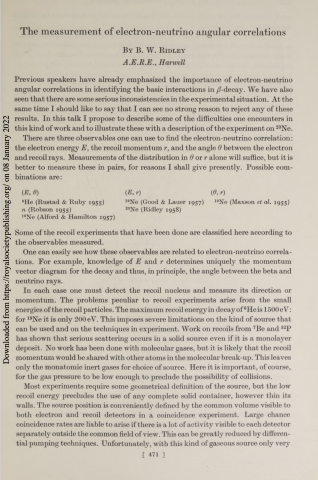The Measurement of Electron-Neutrino Angular Correlations [and Discussion]

Previous speakers have already emphasized the importance of electron-neutrino angular correlations in identifying the basic interactions in β-decay. We have also seen that there are some serious inconsistencies in the experimental situation. At the same time I should like to say that I can see no strong reason to reject any of these results. In this talk I propose to describe some of the difficulties one encounters in this kind of work and to illustrate these with a description of the experiment on 23Ne. There are three observables one can use to find the electron-neutrino correlation: the electron energy E, the recoil momentum r, and the angle θ between the electron and recoil rays. Measurements of the distribution in θ or r alone will suffice, but it is better to measure these in pairs, for reasons I shall give presently. Possible combinations are:
A. Salam, Imperial College: Could Dr Ridley say, if he were asked to choose between these two diagrams, which would he prefer?
B. W. Ridley: I think I am all right in saying that the 35A point is fairly certain, because it would have to move a very long way to change the picture significantly, and one feels that the 19Ne results are significant, merely from the weight of what are now four independent experiments.
A. Salam: So you would be inclined to discount the 6He experiments if you had to choose?
B. W. Ridley: This is rather difficult, because there are always some questions which are left unanswered in any experimental paper, and one can sometimes pick holes in the experiment, but I would not like to do so without the people concerned being here to reply.